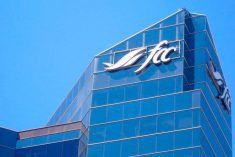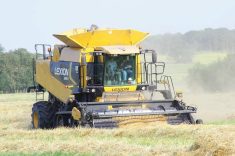There are ways for producers to shield themselves from increased capital gains inclusion, but it may take some legwork and consultation with an expert to determine eligibility, said a chartered professional account from Alberta.
Why it matters: There are ways out there for farmers wanting to protect themselves from a hiked capital gains inclusion rate.
Last June, the Canadian government increased the inclusion rate for individuals and corporations. Capital gains increased from 50 per cent to 66.7 per cent (two-thirds) on gains of more than $250,000 for individuals, creating immediate ire among farmers hoping they’d be spared the hike. Corporations are ineligible for the $250,000 exemption.
Read Also

Ag Days Gives Back 2026 focuses on fire response
Manitoba Ag Days charitable program, Ag Days Gives Back, returns for 2026 with a new wave of rural community support in Manitoba and southeast Saskatchewan
Other than paying more tax, farmers wondered how the new rate would affect succession plans.
“We are disappointed to see the government raise taxes on the succession planning of family-run grain farms today,” said Grain Growers of Canada executive director Kyle Larkin shortly after the inclusion rules took effect in June.
“This hike targets farmers’ retirement plans, increases costs for the next generation and threatens the long-term viability of family farms.”
However, there are legal tools available to cushion the blow from this expanded inclusion rate, particularly in the middle of succession, said Ebony Verbonac, a CPA with KPMG in Lethbridge.
The first thing farmers need to know is that the rollover of farm assets to children or grandchildren is still tax-free, she said.
Farmers must ensure their assets qualify for inclusion under the rollover legislation so they don’t trigger a tax. These qualifications can be a moving target, so be vigilant.
“It’s more important than ever to make sure family members are continuing to ensure that their assets qualify for those provisions and they’re very complicated provisions,” she said.
“If you’re a farmer (who’s) owned your land forever and you’ve farmed it forever and your parents before you farmed it, then you should have no issues.
“But if there’s a piece of land that you bought recently or maybe there’s a period of time that you rented out a quarter because it wasn’t close to other land, if there was any type of separation between you farming it or somebody in your family history farming it or if the farmer was your uncle instead of your father, it can change the game a bit.”
There were a couple of financial tools either introduced or increased in 2024: a hike in the Lifetime Capital Gains Exemption (LCGE) and the introduction of the Canadian Entrepreneurs’ Incentive (CEI), which has yet to be enacted.
Most farmers are familiar with the LCGE, which increased from $1 million to $1.25 million this year, offering extra shelter in the face of the capital gains inclusion spike.
Perhaps the biggest wild card is the CEI, which proposes a reduced inclusion rate of 33.3 per cent (lower than the previous standard of 50 per cent) on a lifetime maximum of $2 million on eligible capital gains. The CEI was introduced in the 2024 federal budget but is still in discussion.
However, advocates are fighting a battle on some of the less farmer-friendly provisions in the incentive, such as built-in vendor financing and its exposure to the tax code’s Alternative Minimum Tax (AMT).
Neither the CEI nor the LCGE are directly related to succession, but they can save parents some money in the process, said Verbonac.
“Those are tax benefits that we try to use in rollover transactions to get some cash back into mom and dad’s hands at an effective tax rate. They’re not really part of the strategy directly to get the assets to the kids.”
Eligible producers could combine the CEI and the LCGE to shelter $3.25 million in capital gains from the two-thirds inclusion, said Verbonac, emphasizing the CEI is still “theoretical” legislation subject to change.
“I don’t want to say it’s sheltered completely from tax, but you can effectively pay a much lower tax rate than the two-thirds inclusion rate.”
However, the CEI has another attribute that may make it less appealing. As it stands, it is set to phase in over five years. This means producers won’t receive the $2 million incentive all at once but instead over a five-year period, leaving them to essentially finance a sale over that period to ensure CEI eligibility.
Vendor financing is common in many other industries (car sales, for one) but rare in farm production, said Verbonac.
“Let’s say, for example, I’m selling a piece of farmland in January. For me to get the full benefit of that CEI as it phases in over a five-year period, I would essentially have to be the bank for my buyer.
“I would have to wait to collect all of my money from you and stretch that out over a five-year period to gain access to the incentive, which is not very logical in the agriculture space because I’m taking on a lot of risk as a landowner in that situation. What if you foreclose? What if you don’t make the payments?”
However, there’s pressure on the government to remove this clause.
“There’s lots of commentary in the marketplace that’s encouraging finance to do that. Do I think it’s going to happen? I don’t know. I wouldn’t want to speculate, but I’m hopeful.”
The AMT could also interfere with the effectiveness of the CEI.
It is a secondary method of determining income tax primarily meant for higher-income individuals with a low amount of tax payable. Advocates are hoping to minimize the CEI’s exposure to this tax tool.
“As it stands right now, if you use the Canadian Entrepreneurs’ Incentive, there could be an AMT cost that could impact the tax savings, especially if you can’t recuperate it,” said Verbonac.
“So, my hope is that when finance comes back with the final legislation, similar to the capital gains exemption, they’ll put in special provisions in the AMT math for people who use the incentive just to grind down the AMT exposure to something that’s more logical than what it would be.”
















